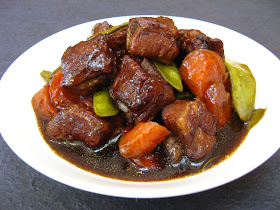This recipe was updated on 13 Aug 2015. Some instructions were
changed.
This dish can be found in all Cantonese style restaurants in
the USA. It’s probably one of the more popular dishes that is ordered by just
about everyone, both locals and tourists, and is almost stereotypical when a
dish is associated with Chinese food in the USA. However, the recipe for this
dish is not like that found in restaurants. In the typical sweet and sour
restaurant dish, the meat and sauce is bright red, being heavily dyed using
food coloring. You will notice that there’s not a speck of red in the sauce or
pork spareribs in this dish. The lack of the red coloring doesn’t affect the
taste in any way. This dish is also healthier than your typical restaurant
sweet and sour dish since the spareribs are braised and not deep fried - if one
can call a pork sparerib dish healthy!
Enjoy!
Ingredients
|
2 lb.
|
1 kg.
|
Pork spareribs (排骨, paai4 gwat1) already cut into
1-2 inch (2.5-5 cm.) pieces
|
|
1 tsp.
|
5 ml.
|
Baking soda (蘇打粉, sou1 daa2 fan2)
|
|
½ in.
|
15 mm.
|
Knob of ginger
(薑, goeng1), crushed in a garlic
press
|
|
2 cloves
|
2 cloves
|
Garlic (蒜, syun3), crushed in a garlic press
|
|
1 Tbs.
|
15 ml.
|
Corn starch (粟粉, suk1 fan2)
|
|
2 Tbs.
|
30 ml.
|
Soy sauce (豉油, si6 jau4)
|
|
1 Tbs.
|
15 ml.
|
Hoisin sauce (海鮮醬, hoi2 sin1 zoeng3)
|
|
2 Tbs.
|
30 ml.
|
Shaoxing rice
wine (紹興酒, siu6 hing1 zau2)
or dry sherry
|
|
½ tsp.
|
2.5 ml.
|
Ground white
pepper (白胡椒, baak6 wu4 ziu1)
|
|
1 tsp.
|
5 ml.
|
Sesame oil (麻油, maa4 jau4)
|
|
|
|
|
|
2
|
2
|
Carrots (紅蘿蔔, hung4 lo4
baak6) cut into 2-inch (5 cm.) pieces on the diagonal
|
|
½ lb.
|
250 g.
|
Snow peas (荷蘭豆, ho4 laan4
dau6)
|
|
|
|
Oil for
cooking
|
Sauce Ingredients
|
1½-2
cups
|
350-500
ml.
|
Brown sugar (紅糖, hung4 tong4)
|
|
1 cup
|
250 ml.
|
Chinkiang vinegar (镇江香醋, zan3 gong1 hoeng1
cou3) or black vinegar (黑米醋, hak1
mai5 cou3)
|
|
2
|
2
|
¼-inch (7.5 mm.) slices of ginger (薑, goeng1)
|
|
3 Tbs.
|
45 ml.
|
Tapioca starch (木薯澱粉, muk6 syu4 din6 fan2)
|
Equipment
|
8 qt.
|
7.5 L.
|
Pot to parboil the beef tendon and outside flank
|
|
|
|
or
|
|
6 qt.
|
5.7 L.
|
Dutch oven
|
|
|
|
Fat separator
|
 |
| Chinkiang Vinegar (镇江香醋, zan3 gong1 hoeng1 cou3) |
Preparation Instructions
-
The pork spareribs can be purchased already cut into 1-2 inch (2.5-5 cm.) pieces or have your butcher cut the spareribs into pieces for you. Wet with water and add baking soda to the pork, allow to tenderize for 30 minutes, and then wash the baking soda from the meat. The baking soda can be omitted but results in the tender meat experienced in restaurant dishes.
- Marinate the pork in a covered container for at least one hour or overnight in the refrigerator with the ginger and garlic crushed in a garlic press, corn starch, soy sauce, hoisin sauce, Shaoxing rice wine or dry sherry, ground white pepper, and sesame oil. If marinating the pork overnight, take it out of the refrigerator at least one hour before cooking.
- The ratio of the amount of sugar and vinegar gives the sauce in this dish its distinctive flavor. Add the Chinkiang or black vinegar to the pot or Dutch oven, then stir in 1½ cups (350 ml.) of brown sugar and taste the mixture. If the mixture is too sour, add more brown sugar until the balance of sweet to sour is balanced to your taste, or if too sweet, add more Chinkiang or black vinegar. Add the slices of ginger and the tapioca starch to the sauce in the pot or Dutch oven. Stir the sauce to mix all the ingredients together.
- Add the pork spareribs and marinade to the pot or Dutch oven.
- Wash and cut the carrots on the diagonal into 2-inch (5 cm.) pieces. Add the carrots to the pot or Dutch oven.
- Wash and remove the string from the snow peas by grasping each snow pea in one hand and pulling the tip the length of the snow pea with the other.
-
Bring the uncovered pot or Dutch oven to a boil over high heat, cover, and then reduce the heat to low and simmer for 40-45 minutes. Add the snow peas during the last 2 minutes of cooking to keep them crisp.
- Transfer the contents of the pot or Dutch oven to a serving dish using a slotted spoon. Remove any excess fat from the liquid using a fat separator and then pour the sauce into the serving dish. Serve with steamed rice.

No comments:
Post a Comment